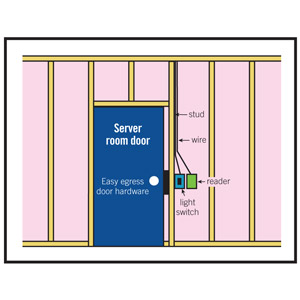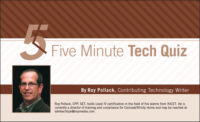1. Wiring installed in conduit for an access control system does not require following the conduit fill requirements of the National Electrical Code because it is low voltage.
a. True
b. False
2. The design of a quality access control system must
a. keep unauthorized people out.
b. allow proper access to authorized personnel without delay.
c. follow fire egress requirements.
d. All of the above
3. Biometric readers are the simplest readers to install since there are no devices needed to be distributed to the users.
a. True
b. False
4. Standard hardwired readers require:
a. Four wires, 16/2 and 18/2
b. Five wires
c. Only data since they are passive
d. Nothing less than 16AWG wire
5. According to NFPA 101, in an assembly occupancy, delayed egress locks
a. are not permitted on any door.
b. shall be permitted on doors other than the main entrance/exit door.
c. shall not be permitted on any doors other than the main entrance/exit door.
d. are not covered by NPFA 101 and this is a trick question.
6. Because of the ability to run wires up to 4000’, __________ is a very popular method of communication between the control and the reader.
a. IP
b. RS230
c. RS485
d. wireless
7. Central intelligence and distributed intelligence are terms that refer to the
a. reader.
b. power supply.
c. control panel.
d. computer.
e. computer and control panel respectively.
8. Electric strikes are normally wired for
a. manual release only.
b. fail safe.
c. fail secure.
d. Push-to-exit mode.
9. Doors in the means of egress ___________ permitted to be equipped with an approved access control system complying with
a. shall not be, NFPA 72.
b. shall be, NFPA 101.
c. may be, NFPA 101.
d. shall not be, NFPA 101.
10. The ______________ specifies the requirements for Special Locking Arrangements.
a. National Fire Alarm Code
b. Authority Having Jurisdiction
c. Life Safety Code
d. National Electrical Code
11. Locks that are designed for applications where the strike plate travels past the magnet during normal door operation are referred to as
a. fail safe.
b. fail secure.
c. shear.
d. maglocks.
12. Delayed Egress locks are permitted on occupancies considered
a. no hazard.
b. high hazard.
c. low and ordinary hazard.
d. B and C.
13. Doors shall unlock upon actuation of which of the following:
a. Approved, supervised automatic sprinkler system
b. A heat detector of a fire alarm system
c. Smoke detectors of an approved fire alarm system
d. Any of the above
14. Loss of power to the part of the access control system that locks the doors shall automatically unlock the doors in the direction of egress.
a. True
b. False
15. Manual activation of a release device shall result in the doors being unlocked
a. until manually reset.
b. at least 60 seconds.
c. no more than 60 seconds.
d. at least 30 seconds.
5-Minute Tech Quiz Answers
1. b — Wiring for access control systems may not be required to be in conduit, but when wires are installed in conduit, the rules for conduit fill must be followed.
2. d — If an access control system is not user friendly, then people will object to and it will not be effective.
3. b — Enrollment is more difficult with biometric readers.
4. b
5. b
6. c
7. e
8. c — The strike will stay locked but allows egress by use of the door handle.
9. b
10. c
11. c
12. c
13. d
14. a
15. d — Always subject to final approval of the AHJ.
| What’s Wrong With This? | |
A technician installed a reader next to the door so that it was easy to present his authorization credentials and enter the facility. However, he was getting intermittent readers and many denials when proper credentials were presented. What did he do wrong?
The technician installed the reader and the reader wires too close to the electric wires controlling the light switch, which was causing interference on his reader. This is also a code violation because he didn’t keep proper separation of the light and power circuit from the Class 2 low-voltage circuit. |



